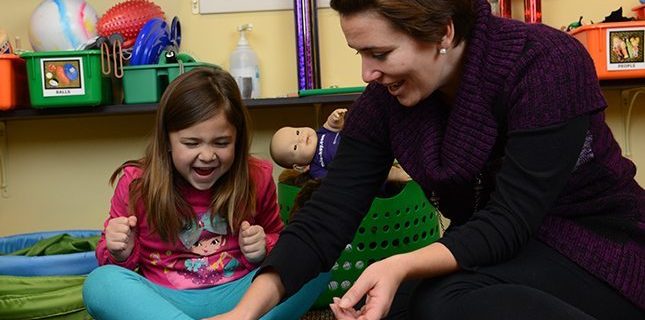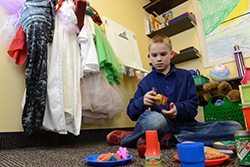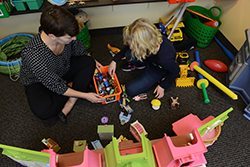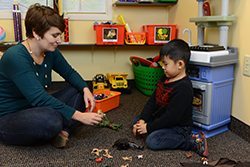5 Misconceptions of Play Therapy

Whether it comes from having medical procedures done or other life events, many children encounter feelings of anxiety or stress that they have a hard time expressing appropriately. Play therapy can be a great way for children to put words to their feelings. If you think your child could benefit from this service, contact our clinical social worker at 651-642-1825.
When Monica began offering play therapy, she encountered a number of preconceived notions people had about play therapy and what it meant for children. She shared a few misconceptions, and the reality behind them, with us – and we wanted to pass them along to you. You can read more about play therapy at PHS in this article MinnPost recently published.
There is no difference between a child just playing with toys and play therapy.
 While play therapy can look like just that – play – to an untrained eye, clinical therapists are able to differentiate between developmental and therapeutic play. Because therapeutic play is all based on metaphor when the child is in a session, play that may look unstructured can actually provide a lot of insight on the stress, concerns or lingering emotional trauma they may carry. In fact, the playroom at PHS offers five categories of toys designed to help children process emotional issues. They include:
While play therapy can look like just that – play – to an untrained eye, clinical therapists are able to differentiate between developmental and therapeutic play. Because therapeutic play is all based on metaphor when the child is in a session, play that may look unstructured can actually provide a lot of insight on the stress, concerns or lingering emotional trauma they may carry. In fact, the playroom at PHS offers five categories of toys designed to help children process emotional issues. They include:
Realistic toys including a real stethoscope, Band-Aids and lab-draw kits.
Nurturing toys including play food, a kitchen set, baby dolls and bottles.
Aggressive toys including chainsaws, guns, aggressive animals, and an angry puppet.
Expressive toys including a sand table, coloring books, and musical instruments.
Pretend and fantasy toys including dress-up clothes and masks
Staff will be able to watch my child while they’re in play therapy to observe the process.
 Similarly to how an adult would never ask to sit and observe another adult in a therapy session, the time spent in play therapy is not an opportunity for professional staff to observe the child working through emotional issues. Although many professionals think the concept of play therapy is really intriguing and would like a chance to see how the process works, Monica takes her clients’ time in the play room very seriously and doesn’t allow others to view the sessions.
Similarly to how an adult would never ask to sit and observe another adult in a therapy session, the time spent in play therapy is not an opportunity for professional staff to observe the child working through emotional issues. Although many professionals think the concept of play therapy is really intriguing and would like a chance to see how the process works, Monica takes her clients’ time in the play room very seriously and doesn’t allow others to view the sessions.
Additionally, untrained individuals will have a hard time deciphering what the play may mean from a mental health perspective, as the therapist has been trained to interpret patterns and themes observed week after week and can often see a story unfold as the client lays it out. It’s important to note that while observers aren’t allowed during sessions, if a child has a home care nurse he or she is allowed to sit in a private observing room so they can monitor the patient’s health during the therapy session. Parents of the client will also be invited to observe from time to time.
I know what my child needs to work on and I can tell the therapist to focus on that issue.
 Parents know their son or daughter well and have likely been through most or all of their medical situations alongside their child. It might be easy to assume their issue is obvious, but letting a child lead the way through therapy and “play it out” can be more telling of what trauma or anxiety they have held on to throughout their experiences.
Parents know their son or daughter well and have likely been through most or all of their medical situations alongside their child. It might be easy to assume their issue is obvious, but letting a child lead the way through therapy and “play it out” can be more telling of what trauma or anxiety they have held on to throughout their experiences.
While there are different approaches to play therapy, Monica follows a non-directive method, meaning she doesn’t tell the child what to do or set guidelines to his or her play. She will consult with parents and caregivers ahead of sessions to understand what concerns there may be, but generally lets the child work through any issues in their own method.
“I think that can be hard for caregivers because they’re used to set rules and guidelines and structure. The play I conduct has structure, it’s just that I’m not deciding it,” commented Monica.
Once they start receiving therapy, the child should be ‘fixed’ soon.
 Often, clients who are beginning play therapy have been encountering events and situations for a number of years (and sometimes their whole lives) that affect their emotional state and level of anxiety surrounding their traumas.
Often, clients who are beginning play therapy have been encountering events and situations for a number of years (and sometimes their whole lives) that affect their emotional state and level of anxiety surrounding their traumas.
“If my client is 5 years old and has been dealing with medical needs for their whole life, the trauma they’ve held onto isn’t going to be resolved in a short period of time,” mentioned Monica. “Sometimes, there are multiple traumas we’re looking at or new events in a child’s life that might set them back and then we kind of start again as we work through those.”
Rather than seeing the process as working to ‘fix’ the child, it should be seen more as giving them new tools to use as they’re coping with future events they go through.
Every child who has a tantrum is in need of play therapy.
 It’s important to recognize the difference between a kid acting like a kid, and a kid acting in a way that suggests they may need therapy or interventions. It may be easy to say that every child who has tantrums is in need of play therapy to work through their frustrations, but many times this behavior is completely age appropriate developmentally, and something the child will work through on their own without the need for therapy. If the behavior doesn’t seem to be age-appropriate, there may be a need for some sort of intervention.
It’s important to recognize the difference between a kid acting like a kid, and a kid acting in a way that suggests they may need therapy or interventions. It may be easy to say that every child who has tantrums is in need of play therapy to work through their frustrations, but many times this behavior is completely age appropriate developmentally, and something the child will work through on their own without the need for therapy. If the behavior doesn’t seem to be age-appropriate, there may be a need for some sort of intervention.
On the other hand, Monica noted that most children with complex medical needs could likely benefit from some sort of therapy to address the potentially traumatizing situations they’ve encountered as part of their care.
Do you have a child or patient who has received play therapy? Are there any misconceptions you had prior to them beginning, that changed after they began going to sessions?
Originally published: June 25, 2015


